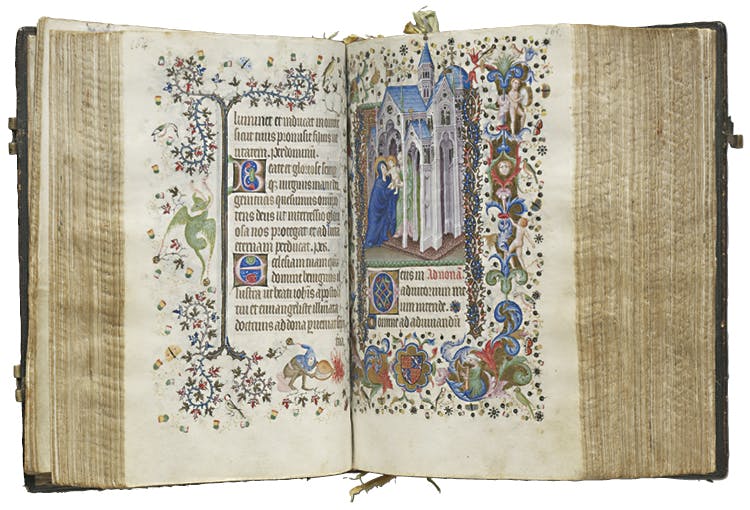
- Magazine Article
- Collection
A Royal Book of Hours
The Hours of King Charles the Noble

Hours of Charles the Noble: fols. 82v–83r: Presentation in the Temple (r. 1387–1425) 1404. France, Paris. Tempera and gold on vellum; each page 20.3 x 15.7 cm. Mr. and Mrs. William H. Marlatt Fund, 1964.40
Within the museum’s manuscript collection is a deluxe book of hours once owned by King Charles III of Navarre, also known as “the Noble,” a term bestowed by Iberians on their most enlightened rulers. From 1387 until his death in 1425, Charles reigned over his small independent kingdom straddling the Pyrenees between northeastern Spain and France. Navarre played a fairly important international role, and its kings had both blood and feudal ties with many other royal houses, most importantly in France. Charles visited Paris in 1404, and that is likely when he acquired this sumptuous book of hours. His coat of arms bearing the royal arms of Navarre quartered with those of Évreux is painted in the lower margin of some 25 folios, indicating that the manuscript was highly esteemed by its owner.

At this time, Paris was the center of the European book trade. This volume conforms largely to Parisian standards of page layout and design. Though the book is written in Latin, its calendar pages are in French and list the customary Parisian saints. For example, Saint Geneviève, patroness of the city of Paris, is listed in gold for January 3. Yet the manuscript is also a work of international scope, reflecting the cosmopolitan character of the French capital, where painters, weavers, sculptors, and goldsmiths from all over Europe converged. The decoration exhibits the courtly elegance and delicate naturalistic details of what art historians call the International Style.
The Hours of Charles the Noble perfectly reflects this artistic milieu. Though the book’s decoration displays a relative aesthetic harmony, the illumination is clearly a collaborative effort involving an international team of artists working in the French capital. There is stylistic evidence of at least six illuminators—two Italians, two Parisians, and two Netherlanders. Nothing is known about the circumstances under which they worked, nor how such disparate painters came to work in Paris on a collaborative project. The two Italians contributed the majority of the volume’s decoration. Stylistically, the manuscript represents one of the most remarkable fusions of French and Italian taste ever achieved.
The illuminator who planned the decoration of the book, and who produced 17 of its large miniatures, was a Bolognese artist known to art historians as the Master of the Brussels Initials, who began his career in the late 1300s in a prominent workshop in Bologna. His name comes from the 15 historiated initials he painted in a book of hours, now in Brussels, commissioned by Jean, duc de Berry. His principal assistant was a Florentine known to us by the name Zecho. In this case we know the artist’s name because he inscribed it on folio 201. Particularly striking and unusual for a Parisian manuscript is the Italianate architecture represented in many of its miniatures. Here, the artist has painted massive, towering buildings with exterior galleries and porticos crowned with domes more in keeping with north Italian buildings than with the linear French Gothic style.
Also of interest in the Hours of Charles the Noble are the rich marginal decorations painted by our Florentine illuminator, Zecho. Page after page is replete with rolling multicolored acanthus leaves with clambering playful drolleries, those hybrid half-human, half-animal figures, some playing musical instruments and some simply making mischief. The marginal decorations are especially noteworthy for their often humorous, eccentric, or plainly irreligious character.
By the early 1400s, books of hours peaked in popularity with European aristocrats and had become the most prevalent volume in the libraries of the nobility. They were the laity’s devotional books, comprising texts such as prayers, psalms, antiphons, hymns, and other material arranged around the eight canonical hours. Such books were commonly decorated with a cycle of miniatures and other illuminations, reflecting the financial means of the patron.

Charles the Noble was such a patron. Crowned (and later buried) in Pamplona Cathedral, he invited French sculptors to decorate it and commissioned Jeannin Lomme of Tournai to construct an imposing alabaster tomb for him and his wife, Leonora of Castille. With its procession of mourners, it was inspired by the celebrated tomb of the Burgundian duke Philip the Bold (1364–1404) in the Chartreuse de Champmol near Dijon. Between 1402 and 1425 Charles also built the stately Royal Castle of Olite, located in the center of Navarre near the banks of the Aragón River. Here he hosted jousts, tournaments, and other games. Visitors marveled at the profusion of orange, lemon, and pomegranate trees and jasmine from Alexandria amid beds of flowers and abundant greenery inhabited by exotic birds and animals.
A German visitor to Olite in the 15th century recorded in his diary, “Surely there is no king with a more beautiful castle or palace and with so many gilded rooms.” Charles, said to have been fond of books, housed a library of substantial size at the Royal Castle of Olite, including treatises, fables, and devotional books. Few of these are known to survive save his book of hours now in the museum’s collection.

